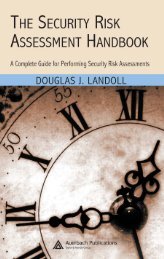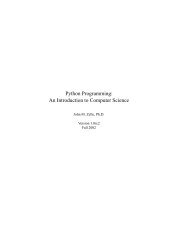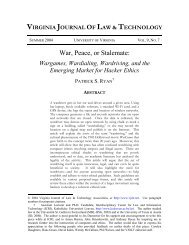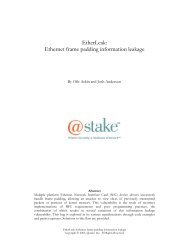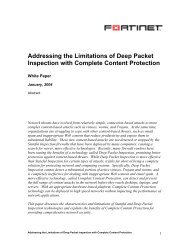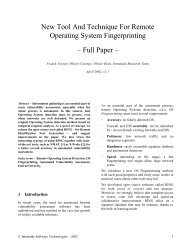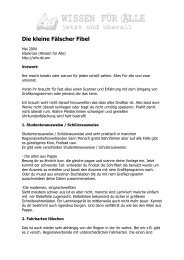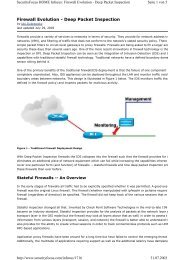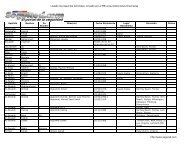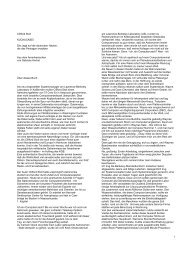ACTIVE DIRECTORY SECURITY CHECKLIST ... - Leet Upload
ACTIVE DIRECTORY SECURITY CHECKLIST ... - Leet Upload
ACTIVE DIRECTORY SECURITY CHECKLIST ... - Leet Upload
You also want an ePaper? Increase the reach of your titles
YUMPU automatically turns print PDFs into web optimized ePapers that Google loves.
Active Directory Checklist, V1R1.2 Field Security Operations<br />
22 September 2006 Defense Information Systems Agency<br />
'Get "Current" Domain Name<br />
Set objRootDSE = GetObject("LDAP://rootDSE")<br />
strDefNC = objRootDSE.Get("defaultNamingContext")<br />
'Get "Current" DC<br />
strdnsHostName = objRootDSE.Get("dnsHostName")<br />
'<br />
'Get Root Domain Name<br />
strRootNC = objRootDSE.Get("rootDomainNamingContext")<br />
'<br />
‘Display the results<br />
strAD_objdata = "Domain Name Data: "<br />
strAD_objdata = strAD_objdata & vbcrlf & "- Root Domain: " & strRootNC<br />
strAD_objdata = strAD_objdata & vbcrlf & "- ""Current"" Domain: " & strDefNC<br />
strAD_objdata = strAD_objdata & vbcrlf<br />
strAD_objdata = strAD_objdata & vbcrlf & """Current"" Domain DC: "<br />
strAD_objdata = strAD_objdata & vbcrlf & "- HostName: " & strdnsHostName<br />
'<br />
wscript.echo strAD_objdata<br />
b. Open a Command Prompt window (“Start”, “Run…”, “cmd.exe”).<br />
c. Execute the script file:<br />
“wscript dir\AD_List_DomNames.vbs”<br />
d. The following items will be displayed in a dialog box:<br />
- The distinguished name of the forest root domain<br />
- The distinguished name of the current domain<br />
- The fully qualified host name of the domain controller where the query was performed.<br />
Note: Execution of this script does not require special privileges beyond user authentication.<br />
Any user who has logged on to the domain can execute this script.<br />
Method 3: Windows Support Tools "ldp" command<br />
a. Start the ldp utility (“Start”, “Run…”, “ldp.exe”).<br />
b. From the Connection menu item, select Connect…<br />
- Leaving the Server field blank on the Connect dialog results in a connection to the current<br />
domain controller.<br />
c. Scan the RootDSE information in the right pane:<br />
- Find the defaultNamingContext entry.<br />
-- The value for this entry is the distinguished name of the current domain.<br />
- Find the rootDomainNamingContext entry.<br />
-- The value for this entry is the distinguished name of the forest root domain.<br />
d. Exit the ldp utility (Connection | Exit).<br />
Note: This use of the ldp (or other LDAP-capable) utility does not, by itself, require special<br />
privileges. Any user who has network access to a domain controller and access to an LDAP<br />
utility can execute this particular query.<br />
UNCLASSIFIED<br />
D-3



